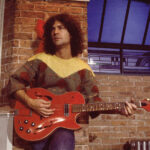The Em7 chord. Just the name itself whispers a hint of musical sophistication and emotional depth. For guitarists, the Em7 chord is more than just a combination of notes; it’s a gateway to a vast landscape of musical expression, lending a touch of melancholy, introspection, or even cool jazz vibes to any song. Composed of the notes E, G, B, and D, the Em7’s unique flavor comes from the minor tonality (G being the flat 3rd of the E major scale) and the added 7th interval (D), creating a richer, more complex sound than a simple E minor.
Fortunately for aspiring guitarists, the Em7 chord is remarkably accessible. Several open position variations exist, perfectly suited for beginners without sacrificing tonal quality. Let’s explore some of the most useful Em7 chord formations on the guitar, dissecting their nuances and discovering how they’re employed in popular music.
Unlocking the Simplest Em7: The One-Finger Wonder
If you’ve already tackled the open E minor chord, or even if you’re a complete novice, this Em7 variation will feel like a breeze. It requires fretting just a single note while strumming all six strings, offering an immediate path to playing this essential chord.
- Middle finger: 2nd fret of the A (5th) string
Strumming all six strings downwards from the low E string produces the notes E, B, D, G, B, and E, from lowest to highest pitch. This voicing delivers a full, grounded Em7 sound, retaining a certain simplicity while still capturing the chord’s inherent depth.
This straightforward yet evocative version of the Em7 chord is famously utilized in Marvin Gaye’s timeless classic, “Let’s Get It On.” The song’s chord progression is intentionally repetitive and uncluttered, a perfect foundation for the song’s sensual and groovy atmosphere. The Em7 here provides a consistent harmonic bedrock, allowing other elements to shine: Gaye’s soulful vocal performance, the signature wah-wah guitar, lush horn arrangements, and the subtly powerful drumming.
Mastering this one-finger Em7 chord is a quick win, immediately unlocking access to iconic songs like this 1973 hit and countless others that rely on its understated power.
Ascending to a Higher Em7: Delicate and Bright
For a brighter, more ethereal Em7 sound, we can explore a variation that sits higher on the fretboard. This voicing omits the lower E and A strings, focusing on the higher frequencies for a more delicate texture.
To achieve this Em7 variation, position your pinky and ring fingers on the 3rd fret of the high E and B strings, respectively. Then, stretch your middle finger to the 2nd fret of the D string (the 4th string in standard tuning).
- Middle finger: 2nd fret of the D (4th) string
- Ring finger: 3rd fret of the B (2nd) string
- Pinky finger: 3rd fret of the E (1st) string
Strumming four strings downwards, starting from the D string, creates this higher-pitched Em7. This version offers a more fragile, shimmering quality, ideal for moments requiring a touch of lightness and airiness.
This particular voicing shines in the bridge of Elliott Smith’s poignant song, “Say Yes.” Featured on his 1997 album Either/Or, “Say Yes” is a masterclass in subtle emotional intensity. The bridge section beautifully highlights the magic of this specific Em7 chord. As Smith sings, “Crooked spin can’t come to rest. I’m damaged bad, at best,” the guitar gracefully navigates through a series of richer chords, with this Em7 acting as a crucial color in the harmonic palette.
The brilliance of this Em7 voicing in “Say Yes” lies in its practicality within the chord progression. The ring and pinky fingers remain anchored on the higher strings across several chord changes, allowing the index finger to efficiently handle the shifting bass notes. The bridge culminates in the song’s central, bittersweet declaration: “They want you or they don’t. Say yes.” This song alone provides ample motivation to delve deeper into the expressive world of guitar playing.
The Full Spectrum Em7: A Rich Six-String Sound
Finally, let’s explore a six-string version of the Em7 chord that combines elements of the previous two voicings. This formation demands a bit more finger dexterity but rewards you with the richest, most complete Em7 sound in open position.
- Index finger: 2nd fret of the A (5th) string
- Middle finger: 2nd fret of the D (4th) string
- Ring finger: 3rd fret of the B (2nd) string
- Pinky finger: 3rd fret of the E (1st) string
Strumming all six strings delivers the full sonic impact of this Em7 voicing. While it requires a slightly wider finger stretch, the resulting sound is significantly richer and more complex, encompassing the full frequency range of the guitar.
As you gain experience, you’ll start to discern the subtle yet significant differences between these Em7 variations. Listening to the opening of the chorus in Oasis’ anthemic “Live Forever” (“Maybe I just wanna fly”) immediately reveals why they opted for this full-bodied Em7. Its richness aligns seamlessly with the band’s penchant for expansive, harmonically full chords. Observing these choices in popular music is crucial for developing your own musical intuition and understanding how chord voicings contribute to a song’s overall feel. Musicians cultivate their signature sounds by carefully selecting these “puzzle pieces” – chord choices, voicings, and rhythmic approaches – to create their unique sonic identities.
To further expand your chord vocabulary, guitarplayers.net offers a comprehensive chord library where you can explore various chord types and find valuable tips for mastering them.
Ready to begin crafting your own signature sound? Explore the world of chords and music that inspires you and unlock your musical potential today!

